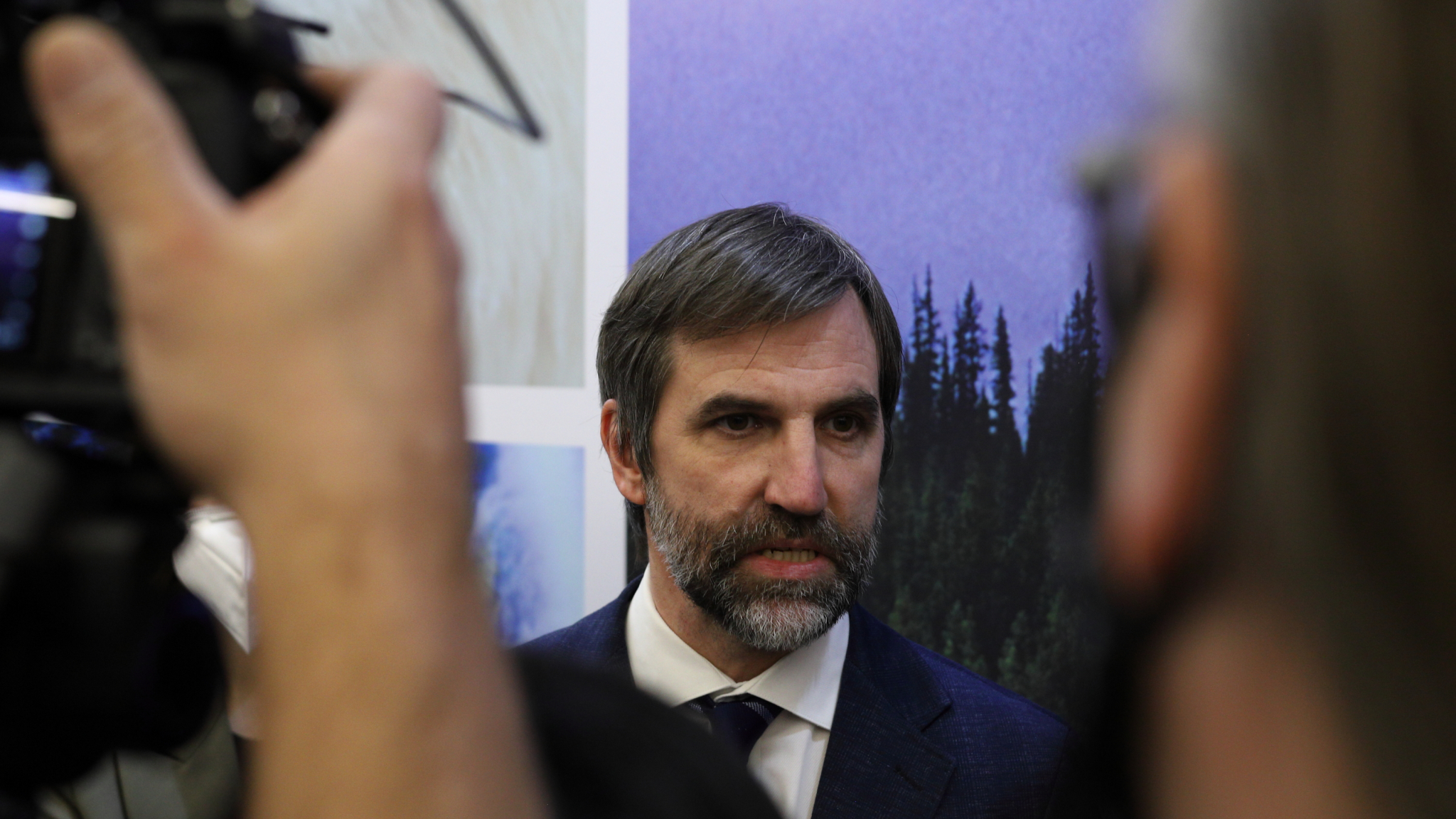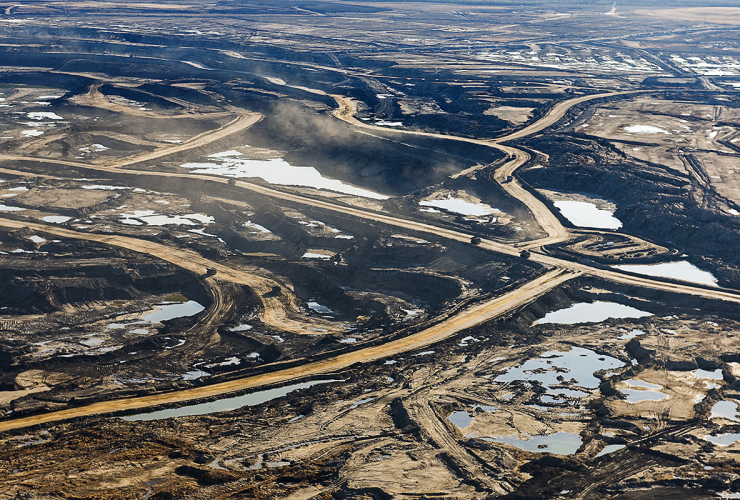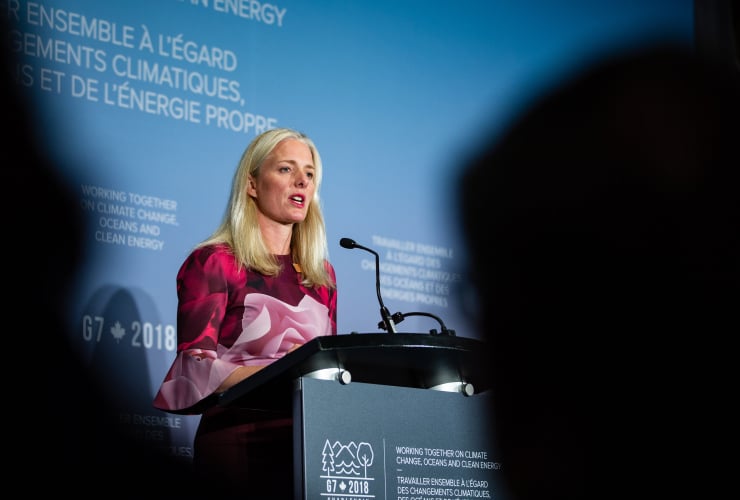Canada’s progress on significantly cutting pollution by 2030 is being undermined by growing emissions from the country’s oil and gas industry, according to the federal government’s annual emissions report to the United Nations.
Overall, Canada's greenhouse gas emissions rose in 2021, the most recent year for which data is available. However, the federal government was quick to note emissions that year were still lower than before the pandemic.
Emissions from the oil and gas sector in particular climbed, but Environment and Climate Change Minister Steven Guilbeault pointed out that the industry's methane emissions — a potent greenhouse gas that has 80 times more planet-warming power than carbon dioxide over the first 20 years — fell by 21 per cent from 2005 levels, calling it a "noteworthy achievement."
For Guilbeault, the annual emissions data published Friday paints an encouraging picture of the country’s climate efforts, despite the oil and gas sector’s growing overall emissions.
“Environment and Climate Change Canada predicted there would be an increase in emissions in 2021 due to 2020’s sudden COVID-19 economic slowdown that caused emissions to drop sharply. But emissions have stayed significantly below pre-pandemic levels,” he said in a statement. “In fact, Canada’s 2021 emissions profile was 53 megatonnes smaller than it was in 2019, before the pandemic, and 62 megatonnes below 2005 levels.”
Visualization based on data from Canada’s Official Greenhouse Gas Inventory. Figures may differ slightly from the 2023 National Inventory Report due to rounding. Infographic by Natasha Bulowski
In 2021, Canada’s planet-warming greenhouse gas emissions totalled 670 megatonnes of CO2 equivalent. That's a 12-megatonne increase from 2020. But a close look at the data reveals the outsized impact of increased emissions from the oil and gas and transportation sectors. Together, those sectors increased their emissions 13 megatonnes from 2020. In other words, those sectors are spewing out more pollution and cancelling out the progress made by other sectors.
Emissions from heavy industry increased four per cent in 2021, or roughly three megatonnes. Another one megatonne increase came from a sector dubbed “waste and other,” which increased by approximately one megatonne.
“We know that climate action is a team effort, and so far, the oil and gas sector has been sitting it out on the bench,” interim executive director of Climate Action Network Canada Caroline Brouillette told Canada’s National Observer. “The good news is that there's a cap for the sector being developed, so the big question now is whether industry will manage to delay, dilute (or) weaken it, or whether the government will be tackling this sector's growing emissions.”
The federal government’s climate plan charts a course for the oil and gas industry — Canada’s most polluting sector — to slash emissions 31 per cent relative to 2005 levels by 2030. This means the sector needs to get its total emissions down to 110 megatonnes before 2030. In 2021, the oil and gas sector emitted 189 megatonnes of planet-warming emissions, or 28 per cent of Canada’s total emissions.
Brouillette says Ottawa’s forthcoming oil and gas sector emissions cap, if designed effectively, would help bring emissions down. She said there are three tests for the federal government to make sure it’s effective:
- That it’s aligned with the Paris Agreement’s goal of holding global warming to 1.5 C.
- That it does not create loopholes by relying on carbon credit offsets, for example.
- That companies will be strictly held accountable to the cap with no exceptions.
A strong cap on oil and gas sector emissions — which will be ready by the end of the year, according to Guilbeault — is key to ensuring the sector delivers the reductions required to stay on track, Keith Brooks, programs director of Environmental Defence, said in a statement.
“Without a robust target for reducing oil and gas emissions at the same levels as the rest of the economy, a greater burden for emission reductions would shift to other sectors, communities and individuals,” he said.
Brooks also poured cold water on Guilbeault’s claim that methane emissions are falling.
“According to the data, methane emissions from the oil and gas industry have fallen since 2005,” he said. “However, the government continues to rely on industry self-reporting, despite independent study after study demonstrating that underreporting is rampant. We need credible data.”
Canada’s climate plan is banking on carbon capture to cut nearly 13 per cent of the oil and gas sector’s projected greenhouse gas emissions by 2030. Oil CEOs have already said they likely can't meet the 2030 target and are lobbying Ottawa for more subsidies to pay for an elaborate carbon sequestration system. At the same time, some think tanks and environmental advocacy organizations are warning the government that carbon capture projects frequently fail to live up to expectations.
Two years ago, as part of its international commitment under the Paris Agreement, Canada pledged to reduce planet-warming greenhouse gas emissions by 40 to 45 per cent from 2005 levels by the end of this decade. The 2021 figures, released Friday, show an 8.4 per cent reduction, which environmental groups and think tanks are celebrating.
The biggest success story by far is a whopping 56 per cent reduction compared to 2005 levels in electricity sector emissions. Unlike other sectors, which have remained relatively stable or seen large fluctuations due to the pandemic, electricity emissions have been on a steady descent since the early 2000s as coal-fired power generation is phased out.
Visualization based on data from Canada’s Official Greenhouse Gas Inventory. Figures may differ slightly from the 2023 National Inventory Report due to rounding. *Waste and others also include emissions from coal production, light manufacturing, construction and forest resources. Infographic by Natasha Bulowski
It’s the one sector we can unambiguously say we’ve made progress on, which is great, James Meadowcroft, a professor of political science and public policy and administration at Carleton University, told Canada’s National Observer.
“The big unknown here, I would say, is transport,” said Meadowcroft. This sector is the second biggest contributor to Canada’s total emissions at 22 per cent in 2021. In the first year of the pandemic, transport emissions significantly dropped. They were on the rise in 2021 but still remained below pre-pandemic levels. The effects of the pandemic are not limited to 2020, so it's hard to tell whether transport emissions are gradually reverting to their previous levels or if some of the reductions will stick.
“Does this data tell us that we're going to make our 2030 targets? No,” said Meadowcroft. “Does this data show that we are keeping a cap on emissions and starting to bring them down? Probably, hopefully,” he said with a laugh. “It's kind of like your blood pressure measurement. It's good for three days.”
Meadowcroft and many climate groups and think tanks want the federal government to update greenhouse gas emission data on a quarterly basis, instead of annually. By the time the national inventory report is published each spring, the data is already 16 months out of date. Yet this information is critical for policy and decision-making to tackle emissions.
“There's no reason this can't be quarterly, like the GDP, and it needs to be quarterly,” said Meadowcroft.
To try to combat this delay, the Canadian Climate Institute will release an independent early estimate of national greenhouse gas emissions eight months before the next federal report.
John Woodside & Natasha Bulowski / Local Journalism Initiative / Canada’s National Observer
"Environment and Climate
"Environment and Climate Change Minister Steven Guilbeault pointed out that the industry's methane emissions … fell by 21 per cent from 2005 levels, calling it a 'noteworthy achievement.'"
Neither industry nor government has a handle on methane emissions. Canada's O&G industry grossly under-reports its emissions of all types, including methane. As numerous studies using actual measurements show, methane emissions from O&G operations are far higher than reported. The industry's GHG emission stats — and Canada's — are fiction.
Canada also uses creative accounting to under-report its forestry emissions:
Barry Saxifrage: "As Canada's forests become carbon bombs, Ottawa pushes the crisis off the books" (March 30 2020)
"Government accounting masks carbon emissions from forestry" (CP, Oct 18 2022)
"An analysis suggests Canada is using questionable methods to dramatically underestimate greenhouse gas emissions from the forestry industry, which it says equal those from Alberta's oilsands in some years."
"Canada’s climate plan is banking on carbon capture to cut nearly 13 per cent of the oil and gas sector’s projected greenhouse gas emissions by 2030. Oil CEOs have already said they likely can't meet the 2030 target…"
13% is grossly insufficient, even if CCS were successful. A 13% reduction using carbon capture will be offset by rising emissions due to increasing production.
What is the government (any
What is the government (any Canadian government) planning to do about the large portion of methane emissions that come from animal agriculture?
"Beef a bigger challenge than oil and gas when it comes to tackling methane emissions in Canada"
https://globalnews.ca/news/8331729/cattle-beef-farming-methane-emissions/
"It May Be Uncomfortable, But We Need to Talk About It"
https://www.colorado.edu/ecenter/2022/03/15/it-may-be-uncomfortable-we-n...
Will we talk about it? Not likely.
"There’s one big subject our leaders at Cop27 won’t touch: livestock farming"
https://www.theguardian.com/commentisfree/2022/nov/09/leaders-cop27-live...
Worldwide, so far EVs and
Worldwide, so far EVs and renewable energy have reduced demand for oil by 1,000,000 barrels a day. So says Chris Turner in his book, 'How to be a Climate Optimist; Blueprints for a Better World.' Betcha didn't know that. He has done the research. Reducing emissions in the transport sector in North America will cause a proportional reduction in demand for Canadian oil. There is more data out today that is now causing analysts to cautiously promote the notion that oil demand is or is about to reach a plateau, dovetailing with Turner's statement. This follows the peak in coal demand and car ownership in 2015-17.
We can document all the political missed targets, rhetorical fluff, misinformation and policies of platitudes over real action 'til cows stop passing methane, but all that accomplishes is to make caring individuals more depressed. The rhetorically negative "war" and "Marshall Plan" and "smash capitalism" narrative on climate action is also depressing (except to the well-known frequent flying climate fighting authors of million-seller books) mainly because it misunderstands the cold economic response to climate.
This is bound to be a marvellous decade of positive change. 2023 is the year that the sodium battery will knock lithium off its perch with affordability and massive storage capacity. Sodium in a hybrid battery with a minor mix of lithium also defeats the poor cold weather performance of today's lithium ion chemistry. In fact, sodium-lithium hybrid batteries operate much more efficiently in very cold weather, making solar (which is also a good cold weather performer) even more viable on the Prairies. That is a very big thing. It directly challenges gasoline and natural gas and their financiers to even exist once solar and wind farms coupled with huge banks of battery packs quickly populate the landscape.
This is not just about electrifying transportation (though that is what gets most of the attention), it's about bringing very cheap and more massive power storage capacity to the grid and pushing wind and solar into a fossil fuel killer overnight. That's only one breakthrough, but a biggie that could blow through all projections of growing oil demand, namely by suddenly outcompeting the internal combustion engine within a few years. It could put some top carmakers into bankruptcy by 2030 as they are drowning in debt while concurrently hanging on to burner car models while EVs eliminate their demand. Some prognosticators are saying that buying a burner car today, even a hybrid, is the realm of fools.
Enviros are likely not even aware of the fact that lithium prices have plummeted by 65% in just the last few months, and analysts peg that to awareness of the power of cheap, ordinary salt to become the most effective power storage material ever realized.
But it's only salt. How boring. Not nearly as exciting or emotionally charged as parsimoniously quoting the lies and meaningless promises our politicians have been flooding us with for decades. You won't make millions from a book on salt and electricity, though they will probably become the most powerful economic disruptors of the world fossil fuel industry with a speed that will shock everyone. It may even lead the Alberta premier and Poilievre to declare war on the oceans of the world.
re "the second biggest
re "the second biggest contributor to Canada’s total emissions at 22 per cent in 2021" is transportation. Take a look at the chart in the article, transport GHG pollution has been increasing almost as fast as from the fossil fuel sector. Why? Largely because the federal and provincial governments have mostly ignored their 2016 commitment to stop funding highway and airport expansion. It is hard to solve a problem when you are spending billions to make it worse. See, for example, my 2020 National Observer article. https://www.nationalobserver.com/2020/03/04/opinion/make-2020-year-peak-car







Comments